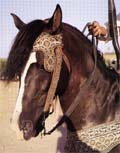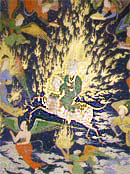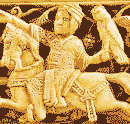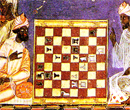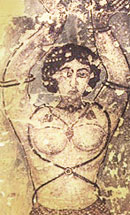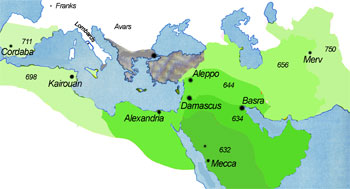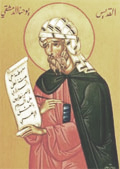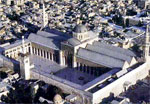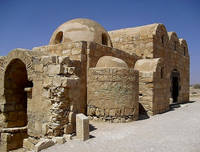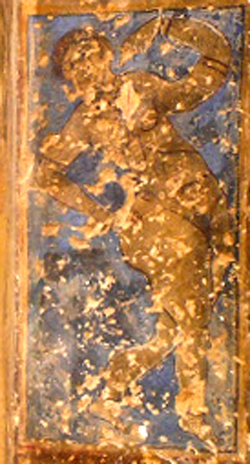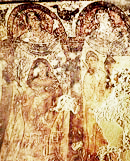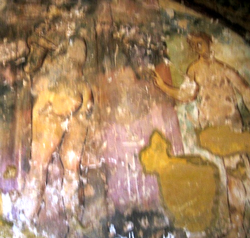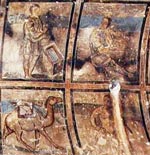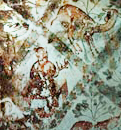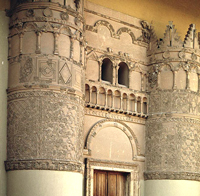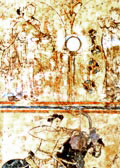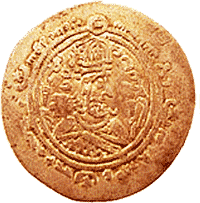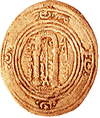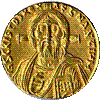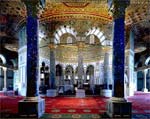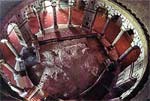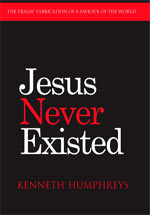Horse Power
"There can be little doubt that of all the horse breeds the Arab has exerted the greatest influence on the world's equine population ... the pedigrees were associated with one or other of the numerous Bedouin tribes ... purity was jealously guarded."
– E. H. Edwards (Horses, Their Role in the History of Man, p31,35)
In the harsh desert environment close living and hand-feeding of horses encouraged loyalty and docility as well as toughness. Selective breeding refined the stock.It was the superiority of Arabian horses which made the vast and rapid conquests of Islam possible.
Not surprisingly, the sale of horses to the infidel was forbidden.
A faceless Muhammad gallops to heaven on horseback.
"A horse scrupulously bred for the Holy War will save his master from the fire on the Day of Resurrection."
– Koran
Dissolution
'The results of a number of recent digs appear to have convinced archaeologists that the entire Levantine coast underwent some form of major economic and demographic crisis towards the end of the sixth century, a full half-century before the Arab conquest.'
– Dalrymple (From the Holy Mountain, p182)
The Cutting Edge
Damascus, capital of the Umayyad caliphate, was the centre of a flourishing artisan industry, producing the world's finest swords and laces, often richly decorated with valuable metals and gems.
The weapons were much prized by Christian knights.
 |
Damascene Steel The strongly curved scimitar (from Persian 'shamshir') made a superior slashing weapon and influenced the development of the European cutlass at the end of the 16th century..
|
Magazine a store of weapons and, later, used for a 'store of knowledge' derives from Arabic 'makhazin'.
Birds of Prey
Ivory from 10th century Fatimid Egypt
Falconry was used by desert dwellers to bring more meat into their meagre diet and is of great antiquity.
The larger birds – peregrines, 'Barbary' and 'Tunisian' falcons – could bring down ducks and catch hares and other small animals.
In the 9th century, as trade with Arabia increased, falconry spread to Europe, and later went 'upscale' to became a sport of the wealthy.
After his crusade of 1228, Holy Roman Emperor Frederick II returned home with experienced falconers from Arabia and Syria, and actually wrote a book 'De Arte Venandi cum Avibus' ('The Art of Falconry').
Pope Leo X (1513-21), besides being an outstanding party animal, was also an avid falconer.
A priest called Luther caused him some upset but he had no issue with religious orders in which falcons were regularly taken into church services.
Simple Pleasures
"Shah mata!"
In 800, Caliph Harun al-Rashid presented the illiterate Frankish warlord Charlemagne with a chessboard. The game was unknown in Christian Europe.
Chess, backgammon and other gambling games of the Saracens proved to be so popular among the crusaders that Richard I issued an edict in 1190 limiting the wagers.
The Church continued to oppose 'idle pastimes' until the end of the 15th century.
Qusayr Amra interior.
Bath houses
Though less grand than the baths of Rome, Arab towns had numerous public bathhouses, with elaborate cisterns for hot and cold water, mosaic floors and a system of underground flues for heating the floors with hot air.
In order to make the best of precious water the 'hammans' rarely had plunge pools but often featured steam rooms – in later centuries called a 'Turkish bath.'
This was at a time when most of Europe never bathed at all.
Most Fragrant Rose
The Damask Rose introduction by crusaders returning to France from Damascus, Syria.
Of the 100 or so books written by Ibn Sina (979-1037) one was a volume devoted entirely to roses.
From the 9th century extensive study of botany was undertaken at Baghdad and Cordova.
The Rapid Advance of Islam A century of almost continuous warfare between the Byzantine and Persian empires depleted the resources of both and diverted trade from the overland routes to the Red Sea. With Petra and the Yemeni kingdoms largely ruined the small but long-established trading city of Mecca, half way up the western coast of Arabia, benefitted enormously. Energised by a new found wealth, and excited by the simultaneous weakness of the two old empires – both of which had confined the Arabs to a role of frontier mercenaries – the desert dwellers were able to raid further than ever before. The first foray into Syria occurred before Muhammad started his proselytising – the defeat of a Persian force in 611. Initial success galvanised the traditionally fratricidal tribes into a formidable army. Welcomed rather than resisted in former colonies weary of imperial exploitation and religious persecution, the Arab warlords adapted themselves to a settled existence. They retained and worked through the established bureaucracy and synthesised a universal religion from elements of both Judaism and Christianity – Islam.
Polyglot Empire In the 7th century Arab armies rapidly overran Byzantine provinces ruined by Justinian and his successors. The warriors of Arabia inherited a major part of the former empire of Rome. To this they added the ravaged empire of Persia. By the 9th century the armies of Islam had triumphed all the way from the borders of China to the Pyrenees. The conquering elite from Arabia now ruled many nationalities – Persians, Indians, Turks, Egyptians, Syrians, Berbers, Andalusians, Greeks and Jews. They had little choice but to rule their provinces through an indigenous intelligentsia drawn, in particular, from minorities – like the Nestorians, Jacobites, Sabaeans and Jews – persecuted by Byzantium. These refugees and outcasts from an intolerant Christendom enthusiastically served their new masters. Crucially, the Arab overlords were themselves civilized and educated by their local administrators. Though much of Roman, Greek and Persian civilization had been lost and theocracy now cast its stultifying shadow in the east as well as in Europe, a new Islamic civilization arose upon the ruins of antiquity.
The Devil Rides Out? One contemporary Christian view of triumphant Islam was that it signalled the 'end time' – the time of 'false prophets' and the reign of the Antichrist. When news of Muhammad had first reached Constantinople he was thought to be yet another Christian heretic, a latter-day Arius from the the desert wasteland. By the time Arab armies were raiding the coasts of France and Italy (they ransacked St Peters in 846) the fear – and hope – of Christendom was that Armageddon had begun. The disaffected native peoples of the conquered provinces saw things rather differently. They had for generations demonstrated a resistance to imperial exploitation by adopting non-orthodox Christianities (Donatism, Monophysitism, Nestorianism, et al). Now 'Islam' offered a dynamic alternative.
Eye Witness The Christian theologian John 'Damascene' (c. 676-754) grew up in the very hub of early Islam – the Umayyad court of Damascus – where his father was imperial chancellor, no less. His grandfather, an Arab Christian called Mansour ibn Sargun, had been the last Byzantine governor of Damascus and had surrendered the city to Khalid ibn Walid in 635. The family remained rich and powerful under the new management and John himself became chief councillor of the city. John's main work 'Fountain of Wisdom' ('Pege gnoseos') catalogued twenty new 'heresies' which had arisen since Epiphanius had drawn up his black list (the 'Panarion') more than 300 years earlier. Islam was one of them.
John, indulging himself of the tolerance of the caliph, Abd al-Malik, denounced Muhammad as 'immoral,' a scandalous polygamist promising an afterlife in carnal paradise, and an imposter who had invented 'revelations from God' as it suited him. John was in no doubt that the 'Saracens' and 'Ishmaelites' were a derivative of 4th century Arianism and 5th century Nestorianism, though he admired their single-minded monotheism. In western Europe Arianism had enjoyed a renaissance under the 6th century Gothic kings, where it had been the faith of the 'ruling class.' More straightforward than the 'divine mystery' of the trinity, Arianism also had no truck with papal imperialism and its meddling hierarchy. Put simply, both the Arians and the Nestorians shared a conviction that Jesus was a lesser being than the God that 'begot' him, and rejected the Trinitarianism adopted as official dogma in Constantinople and Rome at the end of the 5th century. Adherents escaped persecution beyond the imperial frontier, in safe havens in the cities of Arabia and Persia. Here, the 'heretics', in offering competition to Muhammad, helped fashion the new faith from a mix of revised Judaism and unitarian Christianities and made migration to the new religion of 'Islam' a painless affair, particularly as the new Arab overlords were in no particular hurry to make converts. Non-muslims, at liberty to hold important jobs, also paid taxes. Members of the Muslim 'umma' were exempt from tax. The Syrian Connection The earliest conquests by the Arab armies were the Christian-Greek provinces of Syria, Egypt and Mesopotamia. In a marked contrast to Charlemagne's policy in northern Europe ('conversion or death') the Christian populations were also offered a simple choice: accept Islam or pay tax. The lightening success of Arab conquest owes much to its practical moderation. Rome had taken more than a century to subdue Syria, Egypt and the Levant; the Arab armies took less than twenty years to achieve the same purpose.
Syria (which included the area of modern Palestine and Jordan) had been battered by the conflicts between Byzantium and Persia. Antioch, the second city of the empire, had been sacked in 540 by the Sassanian Persians and they did so again, with the support of local Arabs, in 611. Damascus was taken in 614 and Jerusalem the following year (with the Persians making off with that most sacred of all relics – purportedly – 'the True Cross'). Byzantine control was eventually restored in 629, only to be lost again with the Arab victory at Yarmuk in 636. A populous but wrecked province of great and ancient cities was theirs. The new rulers had the good sense to levy lower taxes than the ejected imperialists and set about shifting from a former semi-nomadic existence to a more settled and sophisticated urban style. Within a century new cities were built and old ones restored.
Veneration of Urban Style: The Caliphs Knew How to Party Early Islam was tolerant of competing faiths ('People of the Book') and accommodating of their iconography. Indeed, the conquered lands of 'Coptic' Egypt, 'Monophysite' Syria and 'Nestorian' Iraq were awash with religious imagery. It was part of a heritage extending back thousands of years. Despite later prohibitions early Islamic rulers themselves patronised depictions of both human and animal form, much of it erotic, as rare but telling evidence shows. In 'desert castles' remote from the main urban centres the new masters created for themselves palaces in which to enjoy all the delights enjoyed by earlier elites – whatever the injunctions of their new religion.
Iconoclasm The exclusion of human form from Islamic art dates no earlier than the year 700. Early coinage even carried a monarchical profile even though Islam, like Christianity, inherited hostility to images from the Jews whose 'second commandment' was a prohibition against 'graven images.'
Yet until the iconoclastic campaign of Leo III (717 - 741) the industry of icons was big business in the Byzantine empire and the caliphs employed Byzantine craftsmen and artisans to construct their pleasure palaces. They even built (687-91) the first great monument of a triumphant Islam – the Dome of the Rock – Abd al-Malik's 'alternative' shrine to the Kabah in Mecca, which between 680 and 692 had been controlled by rival caliph Abd ibn Zubayr. Having besieged Mecca and burned the Kabah to the ground, al-Malik ordered construction of the Dome to discourage further pilgrimages to Mecca. Though later embellishments and rebuilding Islamized the structure (the dazzling tiles were added by Suleiman the Magnificent in the 16th century) the building is thoroughly Byzantine in design – and reuses spoil from earlier churches. Subsequently, Islam, perhaps fearful of assimilation – or even a re-emergent polytheism – endorsed its pure, monotheistic credentials. In 723 Caliph Yazid ordered the removal of icons from all Christian churches. The movement paralleled the iconoclasm of the Byzantines.
Sources:
Copyright © 2004 by Kenneth
Humphreys. |
|||||||||||||||||||||||||||||||||||||||||||||||||||||||||||||||||||||||||||||||||||||||||||||||||||||||||||||||||||||||||||||
